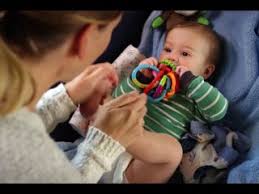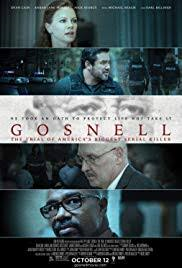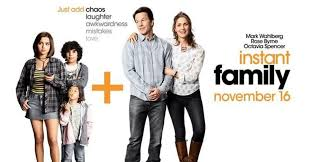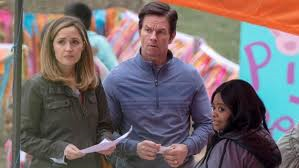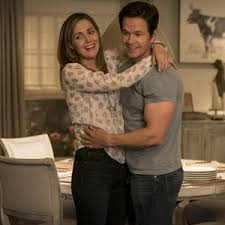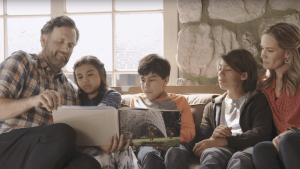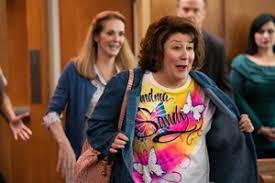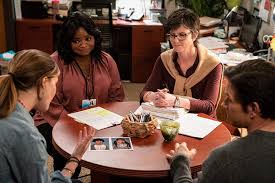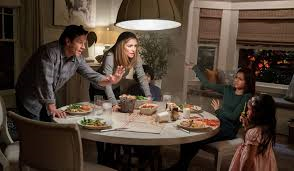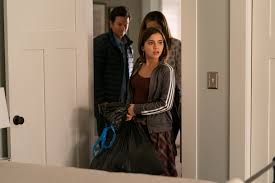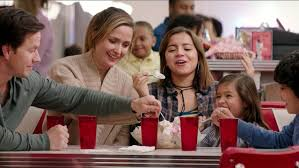AUDIO PODCAST OPTION OF GOSNELL REVIEW
SHORT TAKE:
Documentary-style bio pic about Kermit Gosnell, an abortionist who violated even Pennsylvania’s liberally permissive abortion laws, extending his convictions to include manslaughter of a mother and murder of three full term infants, and the people who brought him to justice.
WHO SHOULD GO:
Adults only – for the topics and many of the visuals of the abortion mill. But of those adults who seek truth or justice, a MUST SEE.
LONG TAKE:
In the movie Jacob’s Ladder, Tim Robbins plays a military veteran suffering from such extreme PTSD that he has visions of hell. 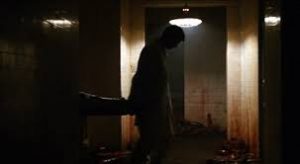 One of those manifestations is of a hospital of filth and gore staffed by demons indifferent to his suffering. While watching that 1990 surreal film, I never dreamed I would one day see real-life footage of the actual place. But footage of a real place, just like Jacob’s visions, were included in Gosnell, the movie about the exposure and trial of
One of those manifestations is of a hospital of filth and gore staffed by demons indifferent to his suffering. While watching that 1990 surreal film, I never dreamed I would one day see real-life footage of the actual place. But footage of a real place, just like Jacob’s visions, were included in Gosnell, the movie about the exposure and trial of 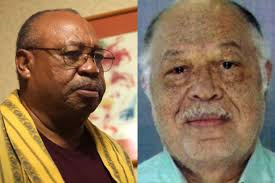 Kermit Gosnell, (portrayed by Earl Billings, a familiar face from many TV shows all the way back to the 1970’s), the perpetrator of the cold blooded killings-for-hire of full-term infants and the casual death of one of his “patients,” who was, to quote Bernard Hughes’ character in the dark satire The Hospital, “neglected to death”.
Kermit Gosnell, (portrayed by Earl Billings, a familiar face from many TV shows all the way back to the 1970’s), the perpetrator of the cold blooded killings-for-hire of full-term infants and the casual death of one of his “patients,” who was, to quote Bernard Hughes’ character in the dark satire The Hospital, “neglected to death”.
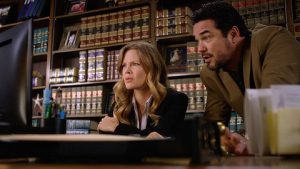 The film, Gosnell, tracks the investigative and legal activities that stopped Gosnell’s Eichmann-like casual killing business. If you see Operation Finale, (to read my blog on Operation Finale click here), you will note the similarities between
The film, Gosnell, tracks the investigative and legal activities that stopped Gosnell’s Eichmann-like casual killing business. If you see Operation Finale, (to read my blog on Operation Finale click here), you will note the similarities between 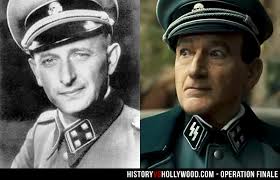 Ben Kingsley’s portrayal of Eichmann and Earl Billings’ Gosnell. Both men had an affluent, family-oriented life.
Ben Kingsley’s portrayal of Eichmann and Earl Billings’ Gosnell. Both men had an affluent, family-oriented life.
While Eichmann’s personal obsessions wandered into the fastidious, Gosnell wandered onto the other end of the bell curve with profound levels of filth. While Eichmann behaves like Lady Macbeth, figuratively (and sometimes literally) trying to wash the guilty stains from his hands, Gosnell wallowed gleefully in the depravity, denying its existence. Both men swam in the blood of others to achieve their goals of career security in an environment and culture which protected their activities for years regardless of the heinousness of the crimes they committed.
The acting in both cases was amazing. 
 Kingsley will likely, and deservedly, be up for awards for his portrayal as the cold, tunnel vision author of the deaths of millions, who wore blinders and chose to see himself as merely a clerk or cog in a machine convenient to his advancement.
Kingsley will likely, and deservedly, be up for awards for his portrayal as the cold, tunnel vision author of the deaths of millions, who wore blinders and chose to see himself as merely a clerk or cog in a machine convenient to his advancement. 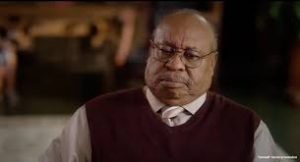 Billings, despite his equally subtle rendition, because of the politically protected nature of Gosnell’s occupation as abortionist, will likely be ignored for his cine-magic contribution. Billings plays a man who, in other surroundings, could be mistaken for a genial, grandfatherly, old-fashioned doctor. It is only the subtle body language, quirks, facial tics and tiny contradictory gestures which visualize Gosnell’s fundamentally broken, corrupted and rotted moral view.
Billings, despite his equally subtle rendition, because of the politically protected nature of Gosnell’s occupation as abortionist, will likely be ignored for his cine-magic contribution. Billings plays a man who, in other surroundings, could be mistaken for a genial, grandfatherly, old-fashioned doctor. It is only the subtle body language, quirks, facial tics and tiny contradictory gestures which visualize Gosnell’s fundamentally broken, corrupted and rotted moral view.
Were the director creating this monster out of whole cloth, he might have been lauded for the extremely effective, visually poetic symmetry of the man’s life. Gosnell lived in a beautiful suburban home, in a Biblical sense the outside of the vase. But the house’s rooms reflected Gosnell’s inner corruption in the piles of trash, the chaotic disorder, Gosnell’s personal hygiene, and the dead animal rotting in a cellar of aggressively flea infested debris.  Gosnell’s clinic, while purportedly there to serve the poor, gave preference to white customers, regularly employed underage untrained teenagers to administer dangerous levels of anesthesia, and
Gosnell’s clinic, while purportedly there to serve the poor, gave preference to white customers, regularly employed underage untrained teenagers to administer dangerous levels of anesthesia, and  housed garbage bags full of decomposing infant parts, casually discarded in hallways, up stairwells, and in so-called operating rooms.
housed garbage bags full of decomposing infant parts, casually discarded in hallways, up stairwells, and in so-called operating rooms.
Likely the only reason this abattoir was not over run with four legged rats was because there was a plethora of irregularly cared for cats who roamed at will using the entire clinic as their kitty box.
Like the serial killer in Silence of the Lambs,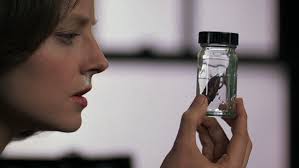 Gosnell
Gosnell 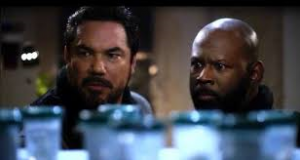 kept trophies in small jars of body parts. So insulated was Gosnell from the rest of the world, humanity, or his own culpability, that he did not understand he was actually displaying evidence against himself.
kept trophies in small jars of body parts. So insulated was Gosnell from the rest of the world, humanity, or his own culpability, that he did not understand he was actually displaying evidence against himself.
None of this was manufactured by the filmmakers. The stomach-churning images were re-created, and in some cases simply copied directly onto the film, from actual footage made by the investigating police officers, there initially to pursue probable cause of the death of one of Gosnell’s victims/patients. 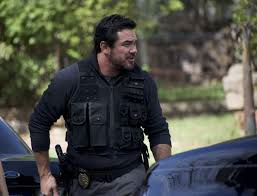 The police entered planning a drug bust. They left with evidence of a serial killer whose murders had been covered up for over two decades by a corrupt Pennsylvania Department of Heath, the steaming environment of political correctness, and the permissive Pennsylvania abortion laws.
The police entered planning a drug bust. They left with evidence of a serial killer whose murders had been covered up for over two decades by a corrupt Pennsylvania Department of Heath, the steaming environment of political correctness, and the permissive Pennsylvania abortion laws.
Despite the heinousness of Gosnell’s activities, the repeated complaints, and the obvious incompetence and flagrant disregard for even the most basic sanitation much less safety of his patients Gosnell was left alone to continue his habits for decades.
It came up in trial that the health department of the state was for at least 17 consecutive years forbidden from pursuing even the most serious of complaints against him because of his status as a black abortionist in a poor neighborhood. But there was no protection for the unwary, vulnerable, scared and defenseless inhabitants that served as Gosnell’s prey.
 Gosnell had no respect for the mostly poor minority women who came to see him, nor the tenants of basic common sense medical sanitation, nor even the law which had closed its eyes to his behavior for so long. Given his protected status it is perversely understandable why he legitimately believed he could get away with murder with impunity.
Gosnell had no respect for the mostly poor minority women who came to see him, nor the tenants of basic common sense medical sanitation, nor even the law which had closed its eyes to his behavior for so long. Given his protected status it is perversely understandable why he legitimately believed he could get away with murder with impunity. 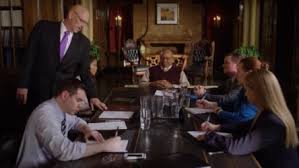 He admitted as much to his attorney when he laughed at his solicitor’s concerns about his legal vulnerability, saying that he was certain no one would question his personal determination of what constituted a human life regardless of the law which forbade abortion passed 24 weeks.
He admitted as much to his attorney when he laughed at his solicitor’s concerns about his legal vulnerability, saying that he was certain no one would question his personal determination of what constituted a human life regardless of the law which forbade abortion passed 24 weeks.
The director, Nick Searcy, 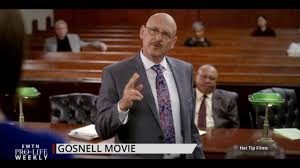 who also plays the defense counsel, Mike Cohan, creates a calm, even somewhat sterile atmosphere for the investigations and courtroom.
who also plays the defense counsel, Mike Cohan, creates a calm, even somewhat sterile atmosphere for the investigations and courtroom. 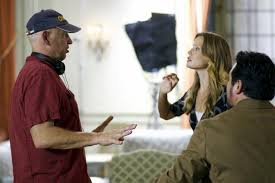 This makes for a relieving counterpoint to the simple video walk-throughs of the “clinic” which view like the abandoned labyrinth of a series of dystopian torture chambers. The supporting characters, from the initially reluctant
This makes for a relieving counterpoint to the simple video walk-throughs of the “clinic” which view like the abandoned labyrinth of a series of dystopian torture chambers. The supporting characters, from the initially reluctant  Asst. D.A. Lexy McGuire (Sarah Jane Morris) to the immediately invested and likeable
Asst. D.A. Lexy McGuire (Sarah Jane Morris) to the immediately invested and likeable 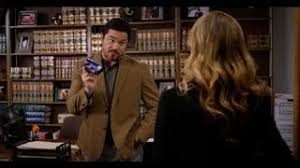 lead detective James Wood (Dean Cain) to the computer geek/blogger
lead detective James Wood (Dean Cain) to the computer geek/blogger  Molly Mullaney (Cyrian Fiallo) do wonderful jobs in solid performances. And the screenwriters, Andrew Klavan, Ann McElhinney, and Phelim McAleer, used composites of real people to flesh and round out the cast. But Billings, as I said, is a standout in the lead with his restrained but utterly creepy portrayal of a man who would fit in a horror movie about a grandfather who hands out razor filled apples and cyanide laced candy on Halloween night.
Molly Mullaney (Cyrian Fiallo) do wonderful jobs in solid performances. And the screenwriters, Andrew Klavan, Ann McElhinney, and Phelim McAleer, used composites of real people to flesh and round out the cast. But Billings, as I said, is a standout in the lead with his restrained but utterly creepy portrayal of a man who would fit in a horror movie about a grandfather who hands out razor filled apples and cyanide laced candy on Halloween night.
Evidence showed Gosnell murdered seven born alive infants. He was convicted of three with an unknown tally of death on his belt over the previous two decades. Gosnell was convicted of one count of manslaughter in the death of a “patient” but who knows how many others died directly from his hands or indirectly from his gross negligence and malpractice. There was evidence of 21 late term abortions, even illegal in Pennsylvania. But who knows how many he committed? And he was convicted of hundreds, out of the likely thousands, of violations of the rules concerning 24 hour informed consent, which are, themselves, but pathetically thin attempts at some common sense to this horrific practice. And all this doesn’t even touch the thousands of babies in the womb he murdered under the auspices of “legal abortion”.
While Gosnell was held to account for his crimes, he was, in truth, merely a symptom of the greater evil of the governmentally, not just allowed, but protected, murder of millions of unborn children.
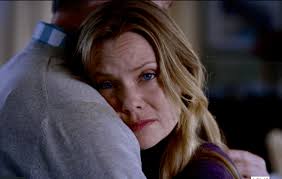 While this is a difficult movie to watch, we must all stand, like the Jews who survived the Holocaust and their descendants, as witnesses to atrocities which should not be happening now and, once defeated, must never happen again. It is our duty to testify against the laws and institutions which allow monsters like Gosnell to exist and thrive, for those already lost and those at risk and yet to be born.
While this is a difficult movie to watch, we must all stand, like the Jews who survived the Holocaust and their descendants, as witnesses to atrocities which should not be happening now and, once defeated, must never happen again. It is our duty to testify against the laws and institutions which allow monsters like Gosnell to exist and thrive, for those already lost and those at risk and yet to be born.